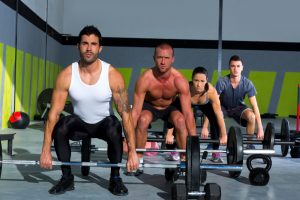Posted on February 09, 2018 by Jenny Cromack
I have said it before and I will say it again, in my humble opinion the Deadlift and ‘hinge’ movement pattern is the most effective exercise that can be performed. It is a compound movement that requires strength, stability and mobility and numerous different joints of the body. It is a fatiguing exercise that activates large muscle groups all at one time – the posterior chain (muscles at the back of your body).

Muscles Used In The Deadlift
• Quadriceps
• Hamstrings
• Gluteals
• Erector Spinae
• Trapezius
• Rhomboids
Who can benefit from deadlifts?
– Strength clients
– Weight-loss clients
– Toning clients
– Athletes
– Lifestyle clients
…Pretty much EVERYONE
Top 5 Deadlift variations
1. Convention Deadlift
Stance: Feet Under the shoulders
Hip/Knee: Hips are a lot higher than the knees, unlike a squat your trunk is lent over the bar.
Key muscles: Hamstrings, Glutes, lower back – a great allrounder!
Other: Shins are very close to the bar.
2. Romanian (RDL)/Stiff Leg Deadlift
Stance: Feet under the shoulders
Hip/Knee: Hips do not move down, hips remain high and knees do not bend.
Key muscles: Hamstrings!
Other: Start from the top. Slight bend in the knee, then keep them locked and hinge from the hip – pushing the hips back and chest forward.
3. Sumo (or my version of hybrid) Deadlift
Stance: Wide, at least two shoe widths further out than the RDL and conventional deadlift.
Hip/Knee: Hips are quite low, still above the knees (so not a squat) but lower than a normal deadlift.
Key muscles: Glutes
Other: Still ensure the chest and head are in front of the bar.
4. Single Leg RDL (dumbbell)
Stance: Single leg
Hip/Knee: Same as the RDL, but one leg will stay straight and swing back as you hinge forward. Allowed a slight bend in the knee but the hips stay very high.
Key muscles: Hamstrings and trunk muscles (stabilisation).
Other: Keep the hips square to the bar. I use a dumbbell to engage the trunk muscles.
5. Split Stance RDL (Landmine)
Stance: Front leg has a ‘soft knee’ like you are setting up for the RDL. The back leg is about a foot behind and up on the toe.
Hip/Knee: SAME AS RDL and SL RDL.
Key muscles: Hamstrings
Other: The landmine helps for stability and makes it easier for increase range of movement.
Remember to keep the spine neutral throughout the movement.

